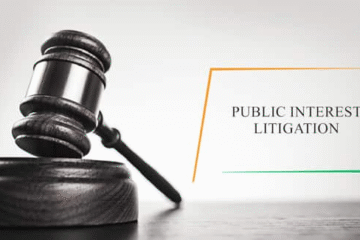This Article is written by Ayushi Sharma, a student of 4th year LLB at RNB Global University,
Bikaner, Rajasthan.

Article 16 states,
- There shall be equality of opportunity for all citizens in matters relating to employment or
appointment to any office under the state. - No citizen shall, on the grounds only of religion, race, caste, sex, decent, place of birth,
residence or any of them, be ineligible for, or discriminated against in respect of, any
employment of office under state.
But the state can make special provisions fora. Making residence as the criteria for employment or appointment within a State or Union Territory, if sanctioned by Parliamentary legislation [Clause. 15(3)].
b. Reservation of appointments of posts for underrepresented backward class [Cl. 15(4)].
c. Reservation in matters of promotion, with consequential seniority, to any class or classes
of posts for SCs and STs [Cl. 15(4A)].
d. Filling up the backlog of vacancies for SCs and STs, irrespective of fifty per cent ceiling
imposed by the Constitution [Cl.15(4B)].
e. Prescription of the profession of a particular religion or belonging to a particular
denomination, if the office is in connection with the affairs of any religious or
denominational institution [Cl.15(5)]
Who are backward classes?
- The words ‘Backward class of citizens’ occurring in Article 16(4) are neither defined nor
explained in the Constitution though the same words occurring in Article 15(4) are followed
by a qualifying phrase, “Socially and Educationally” backward classes. - In Indra Sawhney vs. Union of India, the court observed that certain objectives Social and
other criteria have to be satisfied before any group or class of citizen could be treated as
backward. - ‘Caste’ cannot be the sole criteria in determining backwardness but nevertheless ‘caste’
becomes a dominant factor or primary criterion in determining the backwardness of a class
of citizens. - Other factors like occupation, economic conditions, and social backwardness can be taken
into consideration to determine backwardness. - Backwardness is not a static phenomenon. It cannot continue indefinitely, and the State is
entitled to review the situation from time to time.
Article 16(4) and Article 335
Article 335provides that the claims of the members of the SCs and STs shall be taken into
consideration, consistently with the maintenance of efficiency of administration in the
making of appointments in services and posts in connection with the affairs of the Union or
of a State.
The nine-judge bench of the Supreme Court in Indra Sawhney considered that the mandate
of Article 335 implied that reservation should be read subject to the qualification engrafted
in Article 335 i.e., consistently with the maintenance of efficiency of administration
Indra Sawhney vs Union of India
The Supreme Court in Indra Sawhney vs. Union of India held that – - Ordinarily, the reservation kept both under Article 16(1) and 16(4) together should not
exceed 50 per cent of the appointments in a grade, cadre, or service in any particular year. It
is only for extraordinary reasons that this percentage may be exceeded. - The carry-forward rule is valid but subject to a limit of 50 percent. In this rule, the unfilled
vacancies of the previous year are carried froward to the next year. - Reservations should be confined only to the initial stage of the recruitment and should
not extend promotions. - Reservation xcan be made for backward classes, but the creamy layer should be excluded.
The creamy layer consists of the advanced sections among the backward classes. The apex
court provided some list of creamy layer posts like constitutional posts of President, Vice
President, judges of the Supreme Court, members of the UPSC etc. - The provisions for reservations in the services under Article 16(4) can also be made by
Executive order. - 16(4) is not exception to 16(1).
Is 16(4) i.e. reservations an exception to the general principle of equality of opportunity?
Earlier, it was believed that a reservation under 16(4) was an exception to 16(1). But then
the Supreme Court in Thomas case and then in Indra Sawhney case (Mandal Commission
case) held that clause (4) of Article 16 is not an exception to the rest of the Article, but
rather it is a facet of equality of opportunity guaranteed in clause (1) of that Article and an
effective method of realizing and implementing it. Reservation only further the concept of
equality guaranteed by 16(1). IF we treat unequal equally this would be in violation of
equality. The court held that equality must be among equals. Hence, reservations are a
means to uphold the principle of equality. - No cent percent reservation: The State is not entitled to make a cent percent reservation.
That would be violative of Article 16 of the constitution. The Supreme Court has ruled time
and again, that where there is only one post in the cadre, there can be no reservation for
the backward class. - Concept of creamy layer: In the Mandal Commission case, the Supreme Court has clearly
and authoritatively laid down that the socially advanced members of the backward class,
the creamy layer, has to be excluded from the backward class and the benefit of reservation
under Article 16(4) can only be given to a class which remains after the exclusion of the
creamy layer. This would more appropriately serve the purpose and object of Article 16(4).
The Situation after Indra Sawhney
Some of the things laid down by the Court in the Indra Sawhney case have been
overturned. - Reservations in promotions are now permitted by an amendment to Article 16(4). (85th
Constitutional Amendment Act). - The carry-forward rule is not subject to the 50 percent limit by introducing Article 16(4B).
(81st Constitutional Amendment Act).
M. Nagraj Case:
IN 2006, a five-judge constitution bench of the Supreme Court delivered its judgment in M.
Nagraj vs. Union of India, validating parliament’s decision to extend reservations for SCs and
STs t0 include promotions with three riders. (a) It required the State to provide proof for the
backwardness of the class benefitting from the reservation, (b) Its inadequate
representation in the position/service for which reservation in promotion is to be granted
and (c) To show how reservations in promotions would further administrative efficiency.
Jarnail Singh vs Lachhmi Narain Gupta
The Nagaraj case was reviewed by another five-judge bench in Jarnail Singh vs. Lachhmi
Narain Gupta case in 2018. In this case, the bench held that Nagraj’s insistence on a
collection of quantifiable data on backwardness in relation to the SCs and STs was contrary
to Indra Sawhney, and therefore, bad in law. But the bench approved Nagraj’s insistence on
the proof for the inadequate representation of classes for whom promotional posts are
reserved, and on submission of additional proof that efficiency would not be impacted by
such reservation, because of Article 335. Article 335 mandate that reservations have to be
balanced with the ‘maintenance of efficiency’. Also, the bench is Jarnail Singh held that the
creamy layer principle is an essential aspect of the equality code, and therefore, exclusion of
creamy layer while applying the principle of the reservation is justified, even in the case of
SCs and STs.
Mukesh Kumar vs Sate of Uttarakhand 2020
The SC in the case of Mukesh Kumar vs. State of Uttarakhand has observed that the State
government is not required to justify its decision to not give reservation in promotion on the
basis of quantifiable data. The court also held that no mandamus can be issued against to
provide reservation. The case has heated the issue as to the correctness of reservation in
promotion.
Arguments in Favour of Reservation in Promotions
Such affirmative action seeks to provide a level playing field and equality of
opportunity to the oppressed classes with the overall objective to achieve equality of
opportunity.
The makers of the Constitution used the reservation policy (including in promotion)
for giving protection to the deprived sections of society due to systemic deprivation
of rights, social discrimination and violence.
There is a skewed SC/ST representation at senior levels due to prejudices. Thus,
there is a need for reservation in promotion. For eg.- There were only 4 SC/ST
officers at the secretary rank in the government in 2017.
Further, the case of efficiency and merit in government is sometimes hard to
quantify, and the reporting of output by officers is not free from social bias.
Argument Against the Reservation in Promotions
Provision under Articles 16(4), 16(4A) and 16(4B) of the Constitution are only
enabling provisions and not a fundamental right.
The intent of framers of the Constitution behind including reservations policy was
not reservation without merit.
Gaining employment and position does not ensure the end of social discrimination
and, hence, should not be used as a single yardstick for calculating backwardness.
The Reservation in promotion may hurt the efficiency of administration.
Way Forward
At different levels, studies and empirical data should be collected to decide the level
of promotion needed.
The Constitution envisages not just formal equality of opportunity but also the
achievement of substantive equality. Currently there is an ambiguity in the
promotion process. Thus, there is a need for a new, comprehensive law to be
enacted.
10% QUOTA FOR LOW-INCOME GROUPS
The President has approved 124th Constitutional Amendment Bill (103rd Amendment Act
2019) to give 10% reservation to the economically weaker sections (EWS) of society, over
and above the 49.5% quota in place for SC, ST and OBCs. (It is a type of horizontal
reservation like the PH category not like a vertical reservation for SCs/STs)
Background
2006 Commission : The UPA government in 2006 had formed the commission for
Economically Backward Classes under the ministry of Social Justice and
Empowerment. Maj Gen (Retd) SR Sinha headed the commission. It had given 14
recommendations. One of the major recommendations was to qualify upper caste
members who don’t pay income tax as EWS and treat them at par with other
backward classes.
Other recommendations: The commission also recommended that EWS children
should be eligible for soft loans for higher education, scholarships, coaching for IAS
and PCS exams and subsidized health facilities. Further, they can also be helped
in the housing sector with soft loans.
Provisions of the 103rd Amendment Act
The Act has added Clause 6 in Articles 15 and 16 of the Constitution to extend reservation in
educational institutions and government jobs for EWS. The beneficiary include EWS from all
religions.
Article 15(6): The new Clause (6) to Article 15 allows the government to reservations for the
EWS of society in higher educational institutions, including private ones, whether they are
aided or not by the State. Minority educational institutions are exempted.
Article 16(6): Likewise, the new Clause (6) to Article 16 provides for quota for economically
deprived sections in the initial appointment in government services.
Exclusions: The persons not entitled to EWS reservation includes those family having annual
income above Rs 8Lakh, persons whose family owns or possesses five acres 0f agricultural
land, residential flat of 1000 square feet and above, residential plot of 10 yards and above in
notified municipalities and residential plot of 200 yards and above in areas other than
notified municipalities. The Centre and many state governments have started implementing
EWS reservation provisions.
Arguments in Favour of the Act
50% limit does not apply: The Amendment Act does not violate the Indra Sawhney
judgement of 50% ceiling as it applies only in the case of socially and educationally
backward classes, whereas amendment deals with a quota for the EWS of society.
Implementation of Article 46: The government has invoked the Directive Principles
of State Policy contained in Article 46 to defend its proposal for reservation for the
economically weaker sections. Article 46 says that the State shall promote with
special care the educational and economic interests of the weaker sections of the
people.
De-stigmatization: The people from the SC and ST have supported the amendment
in anticipation that it is the beginning of the process of de-stigmatization of
reservation.
Secular initiative: The 10% quota for the EWS, (those, not SC or OBC) was the first
time in India’s history that a government welfare programme specifically included
Muslims under its umbrella of recipients.
Larger beneficiaries: The EWS reservation cuts across erstwhile limitations of caste
and religion, enabling a policy that serves a larger segment of beneficiaries.
Challenges
Overall issues: It primarily affects the basic structure of the Constitution. At the
same time, the Constitution does not provide for economic reservation.
Against SC decision: Further, the Indira Sawhney judgment has capped the
reservation limit to 50%, but the new amendment increases reservation to 59%.
Moreover, the court has said economically deprived is not a homogenous group, and
economic backwardness cannot be the sole criterion for reservation.
Against Article 14: A total of 59% (49%+10%) quota would leave other candidates
with just 41% government jobs or seats. This may amount to sacrifice of merit and
violate Article 14.
Lack of compelling necessity: similarly, the government has to justify compelling
reasons for going beyond the 50% limit. In some states, upper caste number less
than 10%, and this scheme may be difficult to justify as for 52% backward classes
there is just 27% OBC reservation.
Not a Affirmative Action: Was designed for those who have suffered social
discrimination, not as poverty elevation, employment measure. Thus, the
government has overlooked the fact that upper castes neither face social injustice
nor are subjected to any form of exploitation.
Fluctuating criteria: The economic criteria were to fluctuating a basis for providing
quota.
Limit too High: The cutoff of Rs 8 Lakh is too high and will not benefit the truly poor
families. The national sample survey (NSS) of 2011-12 shows that with this annual
per capita income criteria, 99% of household will fall under this threshold




0 Comments